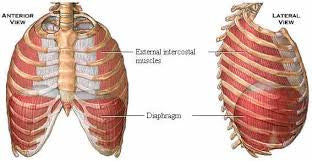
The Slouched & Leaning Position (Part 1): Breathing
DJ GuzdaShare
This is the first post in a series that was developed from our notes on workshop we did on 29 June 2016.
The Problem: We Were Never Taught to Breath
We were born with this ability so we take it for granted; meaning that: we may think that ANY manner in which we breath will provide for us in any and all conditions, environments, circumstances and positions.
" I AM BREATHING" is the common response; or "I KNOW HOW TO BREATH".
Breathing is a physiological response to concentrations of CO2, O2 and changes in pH in our blood. We breath and subsequently engage in respiration,to change these concentrations so we keep them in equilibrium
We have two kinds of 'chemoreceptors' in our bodies that do this. The Central Chemoreceptors are located in the medulla of our brain and primarily detect increases in pH and to a lesser degree CO2 concentrations.
We also have Peripheral Chemoreceptors located in two places in our bodies: the aortic arch of our heart and the carotid arteries. The ones in aorta detect CO2 concentration while the ones of the carotid artery detect CO2,O2 & pH concentrations. These receptors act as little detectors and they communicate with our respiratory centres in the our brain - the medulla and pons.
Left to our own devices, we will breath involuntarily so we may think that conscious breathing is not required.
Take a deep breath in and hold it.
That volunteer action was initiated by the motor cortex of your brain. We can control our breathing and we should seek to do so as much as possible.
Although we can breath involuntary, we can also do so voluntarily and there is great benefit in optimizing both kinds in different situations.
The Muscles Involved in Breathing & Your Posture's Affect on Them
The forward slouching - or C Shaped Position that we often see (or fall into) after long periods of sitting - inhibits the muscles that are involved in diaphragmatic breathing.
Our diaphragm is skeletal muscle that extends across the bottom of your rib cage and sits in dome shaped when it is relaxed. When we take a deep breath in, the diaphragm flattens and thus increases the volume that our thoracic cavity can accommodate. More volume = greater volume or air and potential for increased availability of O2 for respiration.
Other muscles responsible of inspiratory breathing are:
- sternocleidomastoids
- scalenes
- external intercostals
We we are slouched and leaning forward at our desk, our diaphragm is inhibited from doing this and we engage in shallow chest breathing - shortened and shallow breaths that reduce the amount of O2 that is coming into our body. The other muscles involved also strain to do their job and provide large volumes of air for us.
Prolonged shallow breathing can lead to many issues:
- Chronic fatigue
- Impaired cognitive function (decision making ability, staying focused, rational behaviour)
- Sore neck muscles. Sternocleidomastoids and Scalenes assit in deep breathing. When all you do is shallow chest breath, they strain to do one of the jobs they are meant to do and chronic soreness can result.
Shortened and shallow breaths initiates our fight-or-flight response and increases our cortisol levels in our body.
High cortisol levels can do the following:
- Work against insulin and keep glucose free flowing & also increases blood glucose level. The excess glucose is not being used, it can get stored as fat;
- Increase blood pressure ;
- Suppresses the immune system; and
- Reduces protein uptake
The Solution: Voluntary & Diaphragmatic Breathing Through Out Your Day
Making the conscious effort to stand up and move (we will discuss these benefits in a future post) and take deep breaths. When we are engaging in this type of breathing, a deep inhalation should come with the expansion of your abdomen. When you exhale, draw this out for as long as possible. When this happens, you should fee your belly button "drawing in toward your spine".
This can be performed while seat, too. However, you might as well get up, move and change your seated position while you are at it.
If you managed to read to the end of, please comment below! We appreciate your feedback!
*****************
Sources & Further Reading:
- Anna Magee Do you always feel tired, grind your teeth and have neck and shoulder pain? Your BREATHING could be to blame: Experts reveal how to boost your health with these simple exercises (2015) http://www.dailymail.co.uk/health/article-3202475/Do-feel-tired-grind-teeth-neck-shoulder-pain-BREATHING-blame-Experts-reveal-boost-health-simple-exercises.html#ixzz4D5KbIeVL
- Jason H. Mateika, PhD. Control of Breathing , http://www.med.wayne.edu/physiology/facultyprofile/mateika/Organization%20of%20the%20Respiratory%20Control%20System%202007.pdf
- Regulation of Breathing, https://media.lanecc.edu/users/driscolln/RT127/Softchalk/regulation_of_Breathing/regulation_of_Breathing_print.html
- Kelly Starrett, Deskbound (2016)
- Sarah Novotny and Len Kravitz, Ph.D. Science of Breathing, https://www.unm.edu/~lkravitz/Article%20folder/Breathing.html
- Robert Fraser, Mary C. Ingram, Niall H. Anderson, Caroline Morrison, Eleanor Davies, John M. C. Connell Effects on Body Mass, Blood Pressure and Cholesterol in the General Population (1999), http://hyper.ahajournals.org/content/33/6/1364.figures-only?cited-by=yes&legid=hypertensionaha;33/6/1364
- Kristin Giddings, Breathing Properly ? The Harm You Can Be Causing. http://www.parkavenuespine.com/2015/01/breathing-properly-the-harm-you-could-be-causing-yourself/#.V3VY9leFBHg
